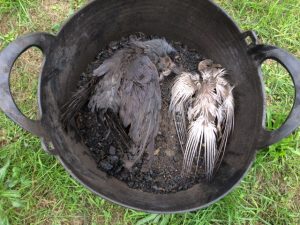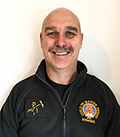Last week I re-attended an address in Abington to remove a bird’s nest from a chimney. I had initially attended the property at the end of May this year when I had swept a Jetmaster open fire configuration in the lounge and attempted to seep a small Coalbrookdale Wood-burning stove in the dining room. I had found that the chimney for this appliance was blocked from the level of the register plate and estimating that the stack was about 14 meters high, I realized that to clear the chimney would take a long and as yet to be determined length of time. Certainly, much longer than I had that day with the number of calls I had booked. I had also noticed that there were Jackdaws perching on the lip of the chimney pot and flying back and forth to the chimney. I surmised that it was these Jackdaws who were the culprits for blocking the chimney with a nest.
Although I’m not much of an ornithologist, I did know something of their nesting habits and was aware that they breed, build or repair their nests between April and July, and that their young are fledged and leave the nest between July and August. So potentially those at the top of the chimney were potentially feeding young in the nest. This would mean that to avoid killing or injuring the young, it would only be safe to sweep the nest towards the end of August.
I additionally knew that although leaving the nest in place until the young are fledged was the ecologically and ethically the right thing to do, it was also a legal requirement. It would actually be breaking the law to attempt to remove the nest in May knowing what I knew and having observed the behaviour of the rooks.
Interestingly, the legislation that covers bird’s nests is ‘The Wildlife & Countryside Act 1981’, The Act states that it is an offence to:
Intentionally kill, injure or take any wild bird
Intentionally take, damage or destroy the nest of any wild bird
while that nest is in use or being built
Penalties for breaking the law include large fines, or up to 6 months imprisonment or both!
In view of all this I arranged with the customer to re-attend at the end of August.
Upon re-attending the address I removed and inspection hatch in the register plate (it was an old style installation with stove pipe into a register plate with inspection hatches and no liner), and discovered that the void between the register plate and the mouth of the chimney flue (approximately two and a half feet), was entirely filled with compacted tar deposits. Having removed this I encountered about three a half meters of nest material consisting of sticks of varying sizes on top of which were two dead birds, one of which was a Rook. Strangely, there was nothing on top of the dead birds; they seem to have been lying on top of the nest.
The photo I took shows the two dead birds lying on top of one of the trugs containing some of the compacted tar I removed from the chimney.
All in all it was quite a mucky, but satisfying job and the customer was pleased that they could now safely use their stove again.



 My name is Paddy McKeown, I am a retired police officer (Detective Sergeant – Metropolitan Police), turned chimney sweep. I have completed training with ‘The Guild of Master Chimney Sweeps’, and Rod Tech UK (Power Sweeping).
My name is Paddy McKeown, I am a retired police officer (Detective Sergeant – Metropolitan Police), turned chimney sweep. I have completed training with ‘The Guild of Master Chimney Sweeps’, and Rod Tech UK (Power Sweeping).




Comments are closed.